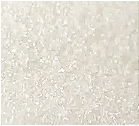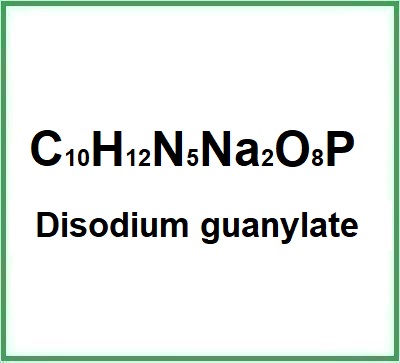Disodium guanylate or Sodium 5'-guanylate is a chemical compound, nucleotide, disodium salt of guanylic acid
It appears as a whitish crystalline powder soluble in water at 50 g/l.

What it is used for and where
Food
Ingredient included in the list of European food additives as E627 as a flavouring agent, flavouring or flavour enhancer very often accompanied by monosodium glutamate.
Safety
In the minimum quantities in which it is included in food or cosmetics, it is of no concern. Check for cumulative intake.
Cosmetics
Humectant. Hygroscopic compound used to minimise water loss in the skin and to prevent it from drying out by facilitating faster and greater absorption of water into the stratum corneum of the epidermis. The epidermis is the most superficial of the three layers that make up human skin (epidermis, dermis and hypodermis) and is the layer that maintains hydration in all three layers. In turn, the epidermis is composed of five layers: horny, the most superficial, granular, spinous, shiny, and basal. Humectants have the ability to retain the water they attract from the air in the stratum corneum and have the function of moisturising the skin. They are best used before emollients, which are oil-based.
Skin conditioning agent. It is the mainstay of topical skin treatment as it has the function of restoring, increasing or improving skin tolerance to external factors, including melanocyte tolerance. The most important function of the conditioning agent is to prevent skin dehydration, but the subject is rather complex and involves emollients and humectants that can be added in the formulation.
Skin conditioning agent - Emollient. Emollients have the characteristic of enhancing the skin barrier through a source of exogenous lipids that adhere to the skin, improving barrier properties by filling gaps in intercorneocyte clusters to improve hydration while protecting against inflammation. In practice, they have the ability to create a barrier that prevents transepidermal water loss. Emollients are described as degreasing or refreshing additives that improve the lipid content of the upper layers of the skin by preventing degreasing and drying of the skin. The problem with emollients is that many have a strong lipophilic character and are identified as occlusive ingredients; they are oily and fatty materials that remain on the skin surface and reduce transepidermal water loss. In cosmetics, emollients and moisturisers are often considered synonymous with humectants and occlusives.
Other uses
Animal feeding
Studies
Lysine at a concentration of 1% and sodium guanylate (300 mg / kg) reduced sensory defects caused by the replacement of 50% salt with potassium chloride, allowing the preparation of sensibly acceptable fermented sausages, with a 50% decrease in sodium (1).
The use of potassium chloride (KCl) has been studied to maintain both the salty taste and to replace the preservative effects of salt when the sodium content in the natural cheese is reduced. Salt substitutes can influence taste because of inherent flavors, such as bitter and metallic, the use of aromatic agents has been investigated for their ability to modulate some of these unwanted sensor effects, including Guanilate. disodium (2).
Study to supress the technological and sensory defects caused by NaCl reduction in low-fat Bologna-type sausages (3).
Study to determine the interaction between the human umami receptor hT1R1 and a ligand while avoiding the cross-talk among various signal pathways in cells (3).
- Molecular Formula C10H12N5Na2O8P
- Molecular Weight 407.184281
- CAS 5550-12-9 85-32-5 117-68-0
- EC number 226-914-1
Synonyms :
- Sodium guanylate
- Disodium GMP
- Guanosine 5'-(disodium phosphate)
- 5'-Guanylic acid, disodium salt
- Disodium guanosine-5'-monophosphate
- Guanosine 5'-monophosphate, disodium salt
- Disodium guanosine 5'-monophosphate
- 5'-Guanylic acid, sodium salt
References__________________________________________________________________
(1) Campagnol PC, dos Santos BA, Terra NN, Pollonio MA Lysine, disodium guanylate and disodium inosinate as flavor enhancers in low-sodium fermented sausages. Meat Sci. 2012 Jul;91(3):334-8. doi: 10.1016/j.meatsci.2012.02.012.
(2) Grummer J, Bobowski N, Karalus M, Vickers Z, Schoenfuss T. Use of potassium chloride and flavor enhancers in low sodium Cheddar cheese. J Dairy Sci. 2013 Mar;96(3):1401-18. doi: 10.3168/jds.2012-6057.
(3) Campagnol PCB, Dos Santos BA, Lorenzo JM, Cichoski AJ. A combined approach to decrease the technological and sensory defects caused by fat and sodium reduction in Bologna-type sausages. Food Sci Technol Int. 2017 Sep;23(6):471-479. doi: 10.1177/1082013217701859.
(4) Huang Y, Lu D, Liu H, Liu S, Jiang S, Pang GC, Liu Y. Preliminary research on the receptor-ligand recognition mechanism of umami by an hT1R1 biosensor. Food Funct. 2019 Feb 25. doi: 10.1039/c8fo02522c.
![]() Disodium guanylate
Disodium guanylate 






